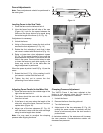
9
3. Tap down the extension table at various points
along its edge where it meets the saw table,
until it is level with the saw table (Figure 7). As
one part of the edge becomes level with the
table, tighten the clamp on that side. Then
move to the other side and repeat, until the full
length of the edge is level with the saw table.
Lay a straight edge across both extension
table and saw table to ensure proper leveling.
When extension table is properly aligned, holes
need to be drilled into the wood table using the
holes in the rails as your guide (Figure 8).
Note: For the following step, you may wish to drill
3/32" pilot holes first.
4. Drill 1/4" holes into the front edge of the table
using the holes in the front rail as a guide.
Note: Drill through the center of the slots – this
will provide lateral adjustment of the rail if
needed later.
5. Drill 1/4" holes into the back edge of the table
using the holes in the back rail as a guide.
6. Referring to Figure 9: Install hex cap screws
(A), flat washers (B), lock washers (C) and
hex nuts (D) into the holes in the front and rear
edges of the extension table as shown.
Finger-tighten only.
7. Re-check the table for alignment, make further
adjustments if necessary, then tighten all
screws and nuts with two 10mm wrenches.
8. Mount the two legs to the inside corners of the
extension table as shown in Figure 10. Secure
with the eight screws provided with the legs.
Note: If you are using a mobile base under your
saw, you may need to shift the placement of the
legs so they rest properly upon the shelves of the
base.
9. Adjust the footpads on the legs
counterclockwise until they reach the floor,
then tighten the nut.
Figure 7
Figure 8
Figure 9
Figure 10


















